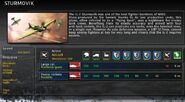The Ilyushin Il-2 is a starting advanced fighter-bomber for the Soviets. Russia's most underrated strength, the Il-2 "Sturmovik" (a heavily-armored fighter designed exclusively for ground attack) is just as powerful against armor as the British Typhoon. It can decimate most enemy armor in one pass, and is able to eliminate light units just as effectively. Alas, the Sturmovik is unable to defend itself very well against enemy fighters, and the Russian fighters are not very capable escorts to go along with it. Use the Sturmovik to attack isolated groups of units without good air cover.
It does have a NATO reporting name, "Bark". The designers called it the "flying tank". The observers called it "humpy". The Germans called it "concrete plane", "butcher", "meat grinder", "Iron Gustav" and "Black Death". 36,183 of these fighter-bombers were built, which makes it the most produced military aircraft ever.
History
Unlike fighter-bombers like the Thunderbolt, the Il-2 was designed from beginning as one tough attack plane. The thick armor was built into the load-bearing frame, allowing to mount a lot of it. The aircraft was slow and cumbersome, but carried a lot of ordnance: rockets, bombs of 100 kg in small wing bomb bays, or hundreds of 2,5 kg shaped-charge bomblets (12370 manufactured). Gun armament consisted of 2 ShKAS 7.62mm MGs and a pair of cannons: 20 mm on prototypes, 23 on frontline version; later experimented with 37 or even 45 mm, the latter deemed useless, and the former causing the plane to stop in midair, by description of the operators.
The two drawbacks was the vulnerable oil radiator and the lack of a rear gunner. Erzats two-seater versions were built as early as 1941, but officially it was issued after a 1942 revision. Armed with a single UBT 12,7 MG, but protected by a thin layer of armor, the gunner was still a crucial upgrade.
Early in the war the Sturmovik performed poorly, because no-one in the field knew how to use it properly. Pilots were under-trained and knew little about the craft's capabilities. The Hero of the Soviet Union medal was awarded after just 10 combat flights. Still, the sheer toughness of the craft earned the love of its pilots - it could land without extending the landing gear, spend a few days in the workshop and get back into the fray.
The Il-10 was a 1945 rework of the craft, more streamlined, faster and with the gunner hidden inside the main armored "bathtub". However, jets came into existence. The Soviet Air Force either gave away or destroyed all piston-powered craft, including thousands of perfectly good Il-10. Until Vietnam everyone believed into "faster, higher, further", but after the US hit a snag and began developing the A-10, the Soviets followed suit. Ilyushin proved he remembered the Il-2 by adding a rear gunner - on a jet-powered Il-102 prototype. Yet Sukhoi won the competition with the Su-25, a tough as nails subsonic single-seat jet that proved a lethal inti-insurgency craft in Afghanistan and Chechnya. It inherited both the class (Sturmovik) and the nickname ("humpy").
Weapons
| Weapon | ||||||||||
|---|---|---|---|---|---|---|---|---|---|---|
Large cal. Machine-guns |
150 | 150 | 16 | 0m |
| Weapon | ||||||||||
|---|---|---|---|---|---|---|---|---|---|---|
Heavy rockets Rockets |
40 | 1440 | 100 | 358 | 179 | 90 | 71 | 42 | 0m |
Gallery
See Also
 Wikipedia: Ilyushin Il-2
Wikipedia: Ilyushin Il-2- Typhoon - British fighter-bomber of equal firepower.
| ||||||||||||||||||||||||||



